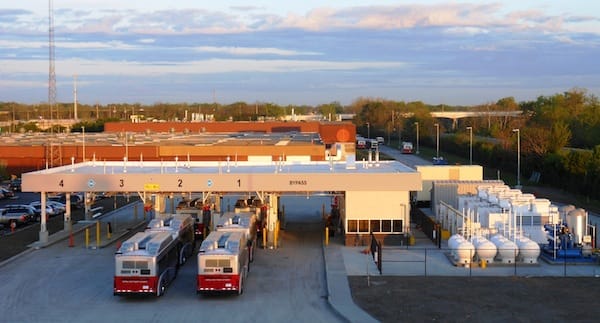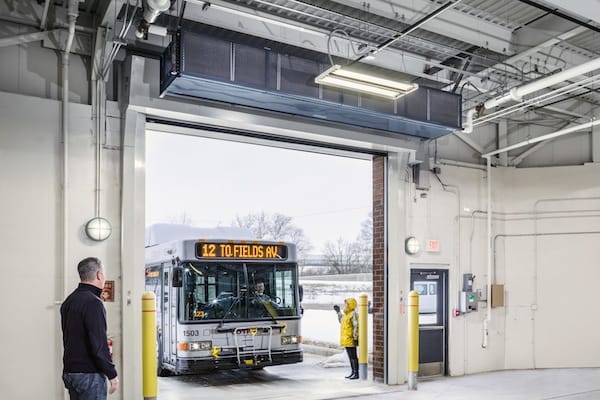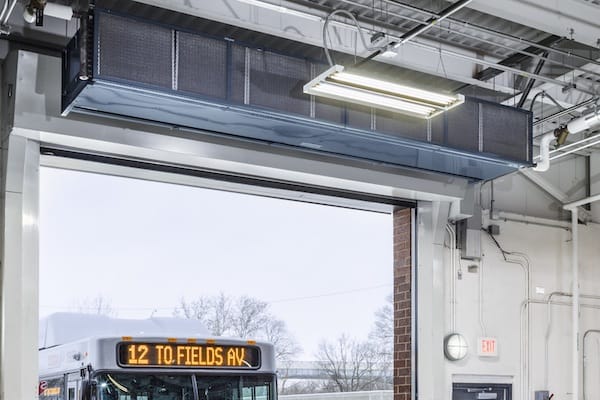Although it’s only 25% completed, the Central Ohio Transit Authority’s (COTA) ongoing $75 million conversion to compressed natural gas (CNG) fueled buses is already saving more than 2.5 million gallons of diesel fuel and emitting 100 tons less bus emission contaminants annually in the greater Columbus, Ohio area.
The bus conversion project’s accompanying HVAC retrofit of the 400,000-square-foot CNG bus maintenance and garage areas into an energy-saving showcase will also preserve the environment and help COTA reach its future Leadership in Energy and Environmental Design (LEED) goal of silver certification.
The recent HVAC retrofit of the McKinley Avenue facility, now ranked as Ohio’s largest CNG fueling station, includes heat recovery air handlers, condensing boilers and 10 environmental-separating air curtains for bus entrances, thanks to the ingenuity of project HVAC engineers and contractors. Key players in the project were architect, R.L. Bowen Associates, Cleveland, Ohio; consulting engineers, Dynamix Engineering Ltd., Columbus; mechanical contractor Kirk Williams Co., Grove City, Ohio; and Jon Hancock, a former COTA transportation facility manager, who oversaw much of the design.
The Phase II mechanical design portion of the three-phase project was particularly challenging in that specification for all airstream ventilation equipment complied with National Fire Protection Association (NFPA) governing standards for compressed natural gases and vehicle fuels such as NFPA-30A, 52, 70, 88A, plus state and local fire marshal compliances. Consequently, airstream electrical-mechanical components comply with precautionary hazardous location (HL)-grade construction, such as explosion-proof motors, spark-resistant fans, HL electrical components and construction, and other life/safety precautions.
In the unlikely event of a bus natural gas leak, a majority of electrical-mechanical devices are constructed to prevent potential gas-igniting arcing and sparking. While unique, these precautions are common specifications for facilities dealing with flammable chemical processing, food grain dust, gases and other ignitable airborne byproducts of some industrial applications.
Consequently, Dynamix Engineering’s equipment specifications mandated combinations of energy efficiency and life/safety measures. For example, seven 14 (h) x 16-foot (l) doorways complement Dynamix Engineering’s energy efficiency model with the installation of air curtains that retain up to 80-percent of the building’s heat during perpetual door cycles as buses pass in and out of the maintenance and garage areas. Three additional air curtains separate environments at one large interior common doorway shared by the maintenance and garage areas. “Using air curtains on those large doorways has proven to be a huge benefit in energy savings and indoor air comfort,” said Hancock.
They’re not ordinary air curtains however. Each 1,600-cfm air curtain from the Hazardous Location Construction (HLC) Series manufactured by Berner International, New Castle, Pa., is constructed of nonferrous metals and features three and five-hp. explosion-proof motors as per Class 1–Group D–Division 1. There are also spark-resistant fans comprised of aluminum blower wheels and other NFPA-compliant components. Even the special zinc-based gray epoxy powder coat finish on the entire interior and exterior cabinetry is chip-resistant to prevent any metal-to-metal sparking-potential contact in the unlikely event of a detached part.
Activated by the opening of their accompanying high speed roll-up door, The 16-foot long air curtains are the longest single construction in the industry and don’t create airstream disrupting obstructions as do models with multiple smaller lengths bolted together.
The air curtains also add to IAQ with optional permanent washable aluminum mesh filters that help remove airborne particulate emission contaminants from the remaining diesel fleet that’s scheduled for phase out in several years. The air curtains also include 708,140-Btu/hr. hot water coils to provide air comfort to employees working near opening doors.
Also complementary to the LEED goal is Dynamix’s replacement of three gas-fired grade-mounted and several hot water indoor air handling systems that were beyond their serviceable life. Replacements consist of 10 exterior grade-mounted and 12 mezzanine-level semi-custom hot water and heat recovery air handlers manufactured by Innovent Air, Minneapolis, Minn. The units feature two-inch-thick insulated double wall construction and fully water-down capabilities While considerably larger to accommodate up to six air changes per hour versus the previous system’s single hourly air change, the energy use is similar. The energy recovering air-to-air heat exchanger is a cross-flow, flat plate type. It’s critical to efficiently maintaining comparatively better 55 to 60°F and 65 to 70°F employee wintertime indoor air comfort for the bus garage and maintenance areas, respectively.
The HVAC system is controlled by a building automation system by Honeywell, Minneapolis, Minn., but also overridden by a 16-zone network of more than 200 combustible gas and carbon monoxide detection sensors, manufactured by Sierra Monitor Corp., Milpitas, Calif. The system perpetually monitors combustible gas lower explosive limit (LEL) levels and signals the air handlers for additional outdoor air when contaminant set points are exceeded. Some of the air handlers have variable frequency drives (VFD) to provide additional outdoor air until gas levels fall below LEL level set points. Persistently high levels eventually open all doors automatically, activate exhaust fans and switch mechanical systems to 100-percent outdoor air to purge the spaces for a complete air exchange in 10 to 12 minutes depending on the space.
Dynamix Engineering’s design also includes 21 exhaust fans ranging from 3,500 to 21,000 cfm that help evacuate detected gases as well as help controlling building pressurization.
Adding to the overall energy savings are two high-efficiency condensing and six near-condensing 3-million Btu/h boilers by the Hydrotherm and RBI boiler divisions, respectively, of Mestek, Westfield, Mass. The boilers supply air curtain and air handler heating coils for wintertime heating.
Dynamix’s lighting retrofit consisted of replacing pulse-start metal halide with T5HO fluorescent fixtures and whitewashing the ceiling for reflectivity has also increased luminosity from 25 to 55-footcandles, while simultaneously improving energy savings by 30%.
The project’s IAQ improvement via increased air changes has not overtly spiked HVAC operational costs due to the combined conservation methods of energy recovery and air curtains. Air comfort was also successfully maintained during last year’s frigid Ohio winter near doorways and elsewhere throughout the facility, according to Hancock.
COTA, which also received three-star-certified Green Fleets Award last September from the Clean Fuels Ohio program, has converted 75 buses to CNG for a savings of more than $1 million in fuel costs and a projected $4 million annually once the remaining 255 diesel buses are converted in approximately eight years. These savings, when combined with the facility operational savings once the third and final phase is completed in 2017, will undoubtedly benefit Ohio taxpayers. Additionally, COTA officials are confident the project will achieve LEED silver certification and serve as an energy role model, not only for Ohio, but also for the trend of CNG-fueled vehicles in public transportation.







Join the conversation: